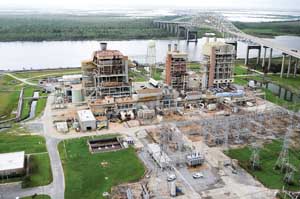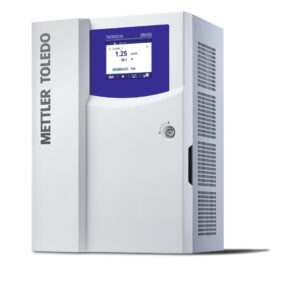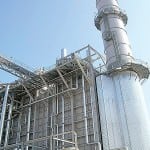Plant engineers are adept at managing and maintaining aged equipment at the 800-MW Michoud power station, located 10 miles east of New Orleans (Figure 3). From November 2006 to November 2007, the generating station’s two units were off line less than 116 hours. Michoud Unit 2 operated 6,770 service hours, and its Unit 3 provided an exceptional 6,946 hours of service.

3. Prime performer. Plant engineers are adept at managing and maintaining aged equipment at the 800-MW Michoud power station, located 10 miles east of New Orleans. From November 2006 to November 2007, the generating station’s two units were off line less than 116 hours. Michoud Unit 2 operated 6,770 service hours, and its Unit 3 provided an exceptional 6,946 hours of service. Courtesy: Hach Co.
One key area at the plant where O&M excellence is evident is in maintaining plant water quality to avoid boiler tube leaks and other problems that can occur when using water that is outside of specification. During the same 2006 – 2007 time period, the 45-year-old Michoud Unit 2 experienced only two boiler tube leaks. Michoud Unit 3, which is 41 years old, had no leaks.
"Protecting boiler and turbine components from repairs and unscheduled downtime is critical," says Vinny Gagliano, water environmental technician for Entergy New Orleans, the subsidiary of Entergy Corp. that owns and operates the plant. "Good sampling, monitoring, and analysis of the steam-water cycle is essential for this, and one of the things we monitor very closely is silica."
Subpar water quality can endanger boiler tubes and piping by promoting corrosion, scaling, and fouling. At high temperatures, water contaminants such as silica can volatilize in the steam and deposit on the turbines or piping. Controlling silica helps avoid scaling and other detrimental effects in boilers, drums, heat exchangers, and condensers, where impaired heat transfer efficiency could ultimately impair production efficiency.
"We want to hold silica to very low levels because we don’t want it to carry over to the turbine blades," Gagliano says. Deposition on turbine blades from silica carryover in steam can result in inefficient and imbalanced spinning as well as thrown blades that directly reduce the plant’s power output and revenue. "Water moving through our boilers, especially our supercritical boiler, must be extremely high quality, since it affects both performance and overall boiler life."
Monitoring Silica Levels
Michoud operates two natural gas – burning units, backed up with No. 6 fuel oil. Michoud Unit 2, a drum boiler, generates 2 million lb/hr of steam yielding 250 MW. Michoud Unit 3, a supercritical boiler, provides 550 MW. Well water supplying both units first enters a reverse osmosis (RO) system consisting of 12 20-micron filters. After RO, boiler make-up water is pumped to the plant’s demineralizers.
When anion demineralizers or mixed-bed polishers approach exhaustion, silica is the first impurity to break through. Four online Hach Series 5000 Silica Analyzers were installed to provide sensitive checks of demineralizer performance at strategic locations and to identify the earliest signs of contaminant breakthrough (Figure 4). The plant also takes online conductivity measurement in the feedwater and steam loops to assess water and steam purity; however, Gagliano says the plant’s first line of defense from impurity breakthrough is the silica analyzers.
"The analyzers detect rising levels of silica far sooner than an increase in conductivity. Dissolved silica gets weakly ionized and is often difficult to detect by conductivity measurement. By detecting dissolved silica quickly (within 8.8 to 15 minutes) and at a low detection limit (0.5 µg/L), the silica analyzers provide us with an early warning that a demineralizer is nearly exhausted," Gagliano says.
Accurate Online Silica Measurement
The Hach Series 5000 Silica Analyzer relies on the silicomolybdate/heteropoly blue method of colorimetric detection at 810 nm, using an internal reference cell to compare with sample measurements. Silica concentration is calculated based on the difference between the two measurements and is shown in µg/L. Any bias caused by turbidity or sample color is eliminated with continuous auto-zero for each sample.
The analyzer uses a pressurized reagent delivery system that makes a peristaltic pump unnecessary. With the reagent chamber pressurized, reagents are automatically supplied to a set of solenoid valves, which release reagents during each cycle in precisely controlled volumes, ensuring accurate analysis. The analyzer provides a digital display of concentration and is auto-calibrating.
"It’s helpful that the unit is self-contained and has no moveable parts," Gagliano says. "Because it’s electronic, we only need air pressure to get the bubbles out of the sample. We used to use another type of silica analyzer that had a small pump to pump out the bubbles, but the tube would continually crack. We haven’t had any problem with these analyzers."
Boiler Make-up: System Overview
In Unit 3, the water is first pumped into cation and anion vessels. The first silica analyzer is located at the anion tank discharge. The water then proceeds to a large mixed-bed column, where a second silica analyzer monitors the effluent.
"Catching silica breakthrough at the anion tank helps preserve the mix bed longer," Gagliano says. "Our silica limit on the anion discharge is 20 ppb, although we like to keep it between 4 and 5 ppb. When the silica levels start breaking, it might take an hour or two and then it breaks out fast. Once that starts to happen, we need to take the anion bed out of service and regenerate it. When the silica starts breaking in the bed it may be 5 ppb, but in a matter of a few hours it might be 30 ppb. Once it exceeds 10 ppb, however, the analyzer sends an alarm."
The silica limit on the mixed-bed polisher is 10 ppb, but it usually runs 4 to 5 ppb. The plant keeps the conductivity on the mixed beds at <0.1 µS/cm.
Following the mixed bed, make-up water is stored in an 800,000-gallon tank. Make-up water for the Unit 3 supercritical boiler has to be high-purity deionized water with virtually complete removal of impurities such as silica. A third online silica analyzer monitors the boiler condensate.
Water quality for the boiler drum in Michoud Unit 2 is not as stringent as that required for the Unit 3 supercritical boiler. A third silica analyzer monitors the boiler drum condensate. Here, the plant maintains a silica limit of 300 ppb, but Gagliano says the plant actually runs it at around 25 to 35 ppb to avoid silica deposition on the turbine blades.
An online Hach 5000 Phosphate Analyzer is also installed to monitor boiler drum condensate. "We want to keep phosphate around 5 to 10 ppb, depending on how many megawatts we have," Gagliano says. "The more megawatts we generate, the more phosphate we need. The analyzer confirms that our target levels are being met."
Maintaining Instrumentation
The Michoud plant entered into a field service partnership with Hach, whereby the instrument manufacturer takes care of everything regarding the plant’s silica and phosphate analyzers, including all parts, labor, and travel. Technicians come to the plant twice a year to perform preventative maintenance. The arrangement includes priority emergency field repair at no additional cost.
Gagliano says the service partnership with Hach has been a big plus. "Like a lot of power plants these days along the Gulf Coast, we’re operating with a lot less manpower. The service program is a valuable time-saver for us."
Under the program, preventive maintenance is conducted on the analyzers according to standard factory recommended schedules, with calibration and certification of the instruments performed on every visit. With the continued success of this arrangement at the Michoud generation station, management recently added a Hach field service partnership to ensure service to 10 Hach Series 5000 analyzers at the Energy New Orleans Nine Mile Plant.
"Having the analyzers routinely serviced is one less thing that we have to do, so we can focus on our job of generating power," Gagliano says.
Quick, Accurate Sampling Data
With power plant personnel reduced in areas such as water chemistry analysis, time saved performing one task allows generating stations more time to get other things done. Controlling impurities in boiler make-up water has enabled Michoud personnel to keep operating costs low and efficiency high.
"Operating decisions still rely just as heavily on water and steam chemistry information, but now there’s a heavy emphasis on obtaining quick, accurate sampling data," Gagliano says. "Our online analyzers are helping us do that."
— Contributed by Andres Meza, Hach Co.









